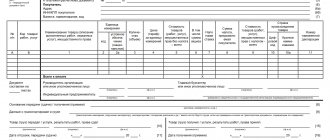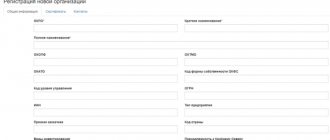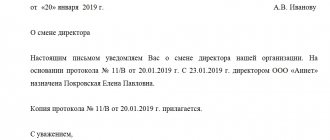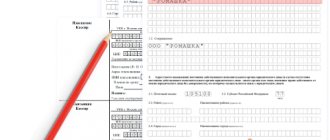Management reports, their purpose
Distinctive features of management reporting from conventional accounting
Financial analysis and planning based on management reports
It was always necessary to generate management reports; the term “managerial” was simply not applied to such internal reports.
Management reporting is a set of internal reports of an enterprise that are generated on a voluntary basis. The main purpose of their compilation is to obtain reliable information about the state of affairs of the enterprise on a specific date, for example, to provide management or owners of the enterprise.
The legislation of the Russian Federation does not provide for unified forms of management reporting due to the voluntariness of its formation, therefore each enterprise has the right to independently develop reporting forms. As a rule, the usual forms of financial statements are taken as a basis.
The main difference between accounting and management reporting is the recipient, the end user. Mandatory accounting reporting is necessary for managers - to analyze the activities of the enterprise for the past reporting period, for auditors and the tax service - to verify the correctness of the reflection of the facts of activity.
Voluntary management reporting is necessary exclusively for the head of the enterprise, his deputies or other authorized persons (management personnel and managers, for example), as well as for the owners of the enterprise to analyze the operation of the enterprise and plan further activities in the short or long term.
In addition, accounting reports are compiled for the enterprise as a whole, and management reporting, if necessary, is presented in the context of structural divisions, separate divisions, subsidiaries, etc. Such detail allows us to identify problem areas.
Note!
Experts in the preparation of management reporting note that you should not overload reports with information, otherwise the document will be difficult to perceive.
The frequency and composition of management reporting depends solely on the requirements of end users (for example, management). Reports can be generated daily, weekly, monthly, quarterly and annually.
As a rule, management reports include planned and actual indicators. This allows you to carry out plan-fact analysis and calculate relative coefficients characterizing the efficiency of financial and economic activities.
This is not a complete list of reports that can be included in management reporting. Let us repeat that the purpose and content of reports directly depend on the requirements of the recipients. Therefore, the following secondary management reports can be generated:
- on the actual cost of production in comparison with planned indicators;
- on the execution of the production plan;
- execution of the marketing plan;
- for work in progress;
- on stocks of raw materials and finished products;
- about accounts receivable;
- about accounts payable, etc.
Management reporting
As always, you have to start with theory. So, what is management reporting ?
This is a set of internal documents containing numbers and their interpretation, which reflect various aspects of the enterprise’s business processes. Management reporting, unlike accounting or tax reporting, is voluntary. This document is not submitted to government agencies; it is an internal, and often secret, document src=»https://pronashidengi.ru/wp-content/uploads/2019/10/28.png» class=»aligncenter» width=»670 ″ height=”500″[/img]
Management Accounting for Decision Support
Management accounting is maintained to help company managers make data-based decisions. All decisions in a company can be divided into rational and non-rational. In order for accounting to meet the expectations of managers, it is important to understand exactly how decisions are made. All people make decisions differently, however, for rational decisions the following sequence of steps can be distinguished:
- goal definition
- searching for alternative courses of action and collecting data
- implementation of selected actions
- comparison of actual results with planned ones
- correction of identified deviations from the plan
Accounting for management means: a mechanism for collecting, processing and translating information to users about the current activities of the enterprise and the external environment in which it directly operates.
Management reporting is a collection of financial and other information about the company, which is an assistant in achieving its goals. His operational information reveals the company's problems and opportunities to solve them.
When problematic issues arise for a company, it is necessary to make the right management decision as quickly as possible. Management accounting provides information for solving problems in this area:
- obtaining all the necessary information for making strategic decisions;
- tracking financial results after decisions are made;
- monitoring how efficiently the enterprise as a whole, structural divisions and individual projects operate.
Management accounting is a system for collecting, analyzing and controlling accounting data that helps in solving specific management problems.
A successfully installed accounting system for management affects the efficiency of management of the organization as a whole. Owners and managers of an enterprise can independently decide on issues related to the organization of accounting: how to classify and detail costs, how to keep records of existing costs, and how to create overall management reporting and control in the organization.
Regardless of the fact that analytical accounting can be built independently, there are starting points that must be:
- goals and objectives must correspond to the specifics of the organization;
- taking into account the features of the process of production of goods or services provided;
- relationship with the general principles of the organizational structure of organization management.
Management reporting challenge
The task of management reporting is to provide reliable data about the company's activities to the management or owners of the enterprise.
Management reporting can complement accounting or financial reporting in order to optimize important business processes and increase profitability. Such reporting may also include non-financial information containing an analysis of the actions taken by the company's management. Management reporting is not valued because it shows big numbers. It is valuable because it shows factual data about the company's activities. This data allows you to detect some issues that interfere with the company's activities. Due to the fact that it contains not only numbers, but also the interpretation of these data. It also contains an analysis of the effectiveness of management decisions src=»https://pronashidengi.ru/wp-content/uploads/2019/10/29. png" class="aligncenter" width="670″ height="500″[/img]
What problems does management accounting solve?
Data-based decision making
There is a misconception that if an organization has properly structured management accounting, then it guarantees good profits. It all depends on the correctness of decision-making by management, based on the information received.
Accounting for management purposes allows management and the owner of the organization to see and understand exactly how the company operates. By keeping records for management purposes, you can obtain the following data:
- what profit does all the current work of the company bring in (BDR: Budget of Income and Expenses);
- identify strengths and weaknesses;
- what costs does the company have and their feasibility (Classification of costs into fixed and variable);
- what costs can be reduced;
- regularity of financial receipts and payments (financial management);
- control over the financial condition of the enterprise as a whole (Financial analysis);
- forecasting unpleasant situations (cash gaps);
- assistance in making the right management decisions (management analysis).
All information received helps in business development.
Analytical accounting makes the financial picture of the organization accessible and transparent for study. Management accounting can be maintained across different time periods: week, month, year. Based on this, it is possible to analyze the dynamics of sales, revenue receipts, expenses, tax payments and a reflection of the real financial result.
Managers and owners may not always be on the territory of the organization. Another advantage of accounting is the ability to monitor the current state of affairs remotely.
Difference between management and accounting reporting
The difference between management, tax and accounting reporting is primarily in the methodology of formation. Tax and accounting reports contain statistical information about the company's activities. In management reporting, the main emphasis is on the interpretation of these figures. Thanks to management reporting, the company's management can not only see certain statistical data, but also understand what they specifically mean in relation to the company's business processes. Thanks to management reporting, the company's management receives information on which business processes the company earns more, and which less, and why. A detailed analysis of data provided in management reporting allows the company’s management to make intelligent decisions regarding the purchase of raw materials, equipment renewal, upgrade of the company’s fixed assets, etc. Timely management reporting makes it possible to identify in which areas the company’s employees are working effectively and in which areas they are not.
How is it formed
Management accounting is a subsystem of another, accounting, which is independently maintained by the company in accordance with the standards established in the organization.
To compile all this correctly, you need to group all the data into 3 blocks:
- position, change and performance;
- key performance indicators;
- budget execution.
Most often, at facilities where they want to implement competent management, they use different reporting formats - on purchases, on GPs, debts, sales or inventories.
In order to unambiguously interpret the received information, it is looked at from different angles and various classifiers are included. How many and which ones exactly is determined based on the direction of the company’s activities, its volume and complexity. You can divide everything by types of consumers, goods, responsibilities or assets.
Contents of management reporting.
Since management reporting is intended for the management of the company in various areas. It will be different because the information for the financial director, and for the development director, or information for shareholders, is needed differently. Therefore, reporting should be different. Depending on who exactly it is provided for. If reporting is generated, for example, for the financial director. It may contain: various financial information, such as data on the execution of the enterprise’s budget; information on costs associated with business activities; figures reflecting the cost of goods or services produced; profit and loss data. If management reporting is generated for the Deputy Director of Sales. It will contain other reports such as information on the sales structure; data on the dynamics of product shipments; information about stocks in the warehouse; data on the cost of selling goods or delivering to consumers; planned indicators regarding the receipt of goods at the warehouse; information on accounts receivable for sold items.
One report can be designed as a table, another as a graph, and various examples can be given in the report to make it more clear.
As you can see, each manager heading a certain direction has his own list of reports included in management reporting. To avoid discrepancies, I strongly recommend working through this moment “on the shore”. In order to make it clear in advance what kind of reporting and for whom, it is necessary to generate. A sample of each report must be agreed upon with interested parties.
It is also necessary to discuss the frequency of generation of management reporting. Because some data is needed once a month, and some every day. It is better that all these points, in terms of the composition of management reporting and the frequency of its formation, are recorded on paper.
Business management experts highly recommend it. Pay special attention to the preparation of reporting for shareholders. Shareholders often do not directly participate in the company's activities. They are more interested in information about the profits or losses received. Also, key shareholders may need an analytical report on the composition of the company's top management. Since the types and forms of management reporting are not regulated by Russian legislation. They can and should be specified in the company’s internal documents. It is good if the reports are pre-agreed by the interested manager and the person preparing the reports.
The person responsible for the formation of such reporting, first of all, must receive information about which manager and what kind of reporting should receive. What is the reporting frequency? Which reports are priority and which are secondary.
Creating a Report (budget) of income and expenses in WA: Financier
A specialized solution based on 1C, for example, WA: Financier, can help greatly simplify management accounting and overcome all the listed difficulties. The system offers its own “philosophy” of accounting, based on the best practices and experience of specialists, is flexibly customized to the individual needs of the customer, “stands” separately from the regulated accounting base, consolidates data by setting up an exchange, which helps to avoid double entry, and also, since it is developed in the 1C environment, has an interface and operating logic familiar to many.
Go to the “Custom reporting - Custom budgets” section, click the “Create” button.
Fig.5 Arbitrary budgets
We assign a name and type to the report.
Fig.6 Creating a custom budget
We select the budget items (items) that will participate in the report.
Fig.7 Budget items
We assign a key and sign for each article.
Fig.8 Setting up an article
We make general settings for the entire report on the second tab “Settings”
Fig.9 General settings
Set up the necessary groupings and click “Create”.
Fig. 10 Groups
The report has been generated.
Modern solution WA: Financier for management accounting, standard implementation in 1 month.
Fig. 11 Budget of income and expenses
In addition, the Report (Budget) of income and expenses can be generated using standard reports in the Budgeting-Budget Execution section and click the generate button
Fig. 12 Budget execution
We get a budget of income and expenses.
Fig. 13 Budget of income and expenses
A similar report on cash receipts and debits (CBDS) is available in the WA: Financier module. Cash management.
Fig. 14 Execution of BDDS
In the “Settings” section, you can flexibly manage the detail of the report - generate it in the context of any available analytics, by group of companies, by any central federal district, organization, etc.
Fig. 15 “BDDS Execution” settings
Stages of generating management reporting.
- The first stage involves collecting various data. This may be several data packets. Such as accounting data, sales data, production data and personnel data.
- The second stage is the analysis and interpretation of data. At this stage, the data is processed. Various analytical reports and interim reports are being generated.
- At the third stage, management reporting is directly generated.
Recommendations for preparing management reports in Excel
At each enterprise, depending on its line of activity, management reporting differs in form, content, and regularity of preparation. But there are general recommendations on how to create management reports in Excel faster and more accurately:
- Separate tables
Each table should be assigned a separate sheet and not try to fit all the indicators into one. This will greatly facilitate the search for the necessary information and the readability of the data, especially for detailed reports. - Sort data by category
Place source data for different categories of products or services on separate sheets, and on the first - a pivot table with total values. This format for presenting information will be clearer and more convenient for users. - Use directories
Business unit directories make your work much easier. With their help, you can significantly save time on compiling similar accounting tables by using auto-fill in cells. - Use the additional functionality of Excel
Do not neglect analytical functions - dispersion, correlation, mathematical and average expectation, extrapolation method and others. They will allow you to identify the main trends in business development and respond to them in a timely manner. - Create correction sheets
Make corrections on special correction sheets. Reports must be prepared according to a single standard without additional corrections by hand. - Create test cells
When transforming data, highlight test cells with color or another method. They will attract attention and help you not to miss mistakes. - Use the protection settings.
Control sheets of reporting forms must be protected from changes.
The most important advantages of the Excel program for management accounting are accessibility, the presence of the necessary set of functions for quickly processing data sets, and the ability to automate similar operations. A well-established accounting system will allow you to regularly conduct analytics on the actual state of affairs at the enterprise with minimal time and in a convenient format.
Hone your Excel knowledge and skills with our training on budgeting, macros, data visualization, basic tools and advanced capabilities!
Excel for financier
What program do you use for management accounting?
Basic management reporting documents:
- A management balance sheet is a document similar to a balance sheet. Its advantage is that it provides not only numbers, but also an interpretation of these numbers from the point of view of the efficiency of business processes.
- Income Statement – The document also contains information from the accounting report, plus analytics and interpretation of these figures.
- Cash flow statement. This report records the company's financial receipts in correlation with sources, as well as company payments in relation to the main areas of expenses - also in relation to the reporting period. A cash flow statement can show how a company is doing in terms of actual production performance and liquidity. This document allows you to assess your creditworthiness src=»https://pronashidengi.ru/wp-content/uploads/2019/10/Illyustratsii-dlya-bloga-1.png» class=»aligncenter» width=»670″ height=» 500″[/img]
Of course, these documents can also be supplemented by others, as necessary, I have listed only three main ones.
Accounts receivable and payable report
The report on receivables and payables can be combined into one management document or divided into two independent documents. It allows you to assess the solvency of an enterprise and track debt turnover using relative ratios.
The very fact of the formation of receivables and payables is inevitable due to the temporary gap between payments and the transfer of finished products.
For your information
Accounts receivable are funds owed to the company by debtors; Accounts payable are funds that a company owes to its creditors.
A report on accounts receivable and payable is compiled as of a specific date, and the final recipient sees information about the status of settlements with counterparties and can quickly monitor the fulfillment of obligations.
An example of a management report on receivables and payables of an enterprise is in table. 9.
Table 9
Report on receivables and payables as of July 21, 2017
| No. | Debtors/ Creditors | Amount, rub. | Shipment | Payment made (advance payment) | Amount of debt as of July 21, 2017 | ||
| date | Amount, rub. | date | Amount, rub. | ||||
| 1 | Debtors | ||||||
| 1.1 | Beta LLC | 11 000 000,00 | 23.06.2017 | 11 000 000,00 | 16.06.2017 | 5 500 000,00 | 5 500 000,00 |
| 2 | Creditors | ||||||
| 2.1 | LLC "Norman" | 1 100 000,00 | 15.06.2017 | 1 100 000,00 | 09.06.2017 | 880 000,00 | 220 000,00 |
Analyzing the report data, the manager will see that on 06/09/2017 the company advanced 80% to Norman LLC (RUB 880,000.00). Products were shipped in full on June 15, 2017. But as of July 21, 2017, the company had not yet finally paid off its debt in the amount of RUB 220,000.00.
At the same time, Beta LLC made an advance (50%) in the amount of 5,500.00 thousand rubles, the products were shipped in full on June 23, 2017. But the company has not received the final payment of 50%.
As a rule, contracts with counterparties specify the terms of delivery and the time interval between delivery and final payment (for example, final payment is made within five working days from the date of acceptance of the delivered products by the buyer). For violation of payment deadlines, sanctions are expected (for example, a penalty in the amount of 0.1% of the amount of the delayed payment for each day of delay).
Therefore, in the event of claims from creditors, the company will be forced not only to make a final settlement, but also to pay penalties, and these are additional unforeseen costs.
Difficulties in generating management reporting.
- The main problem in generating management reporting is that some workers in various fields, from production representatives to top management. They do not consider it necessary to spend their time helping in the formation of this type of reporting, arguing that the company already provides a lot of reports to government agencies.
If this happens. It is necessary to first explain the benefits of providing such data. First, top management, because it is for them, first of all, that this information is needed. Then, they will convey the need for assistance in collecting data to lower-level employees of the company.
- Another difficulty is the need to make changes to the principles of interpreting numbers when business processes change in a company. After all, the company's performance has improved in the past thanks to management reporting. This does not guarantee this in the future if changes have occurred in the structure of the company’s business processes that are not reflected in management reporting.
The solution to this problem is seen in holding regular meetings with key employees of the company. For changes in the business model or business processes src=»https://pronashidengi.ru/wp-content/uploads/2019/10/34.png» class=»aligncenter» width=»670″ height=»500 ″[/img]
Dupont model
Known as a methodology of financial analysis through the analysis and examination of certain ratios that determine the profitability of a business, this model is a well-known method first proposed at the dawn of the twentieth century. The model is a factor analysis, that is, the identification of key factors that influence the efficiency of an organization's management.
The purpose of this analysis is to determine the methods of marginal profitability of invested capital for shareholders, and the latter is reflected by profitability indicators. Since profitability management has become the main issue for the management of the enterprise, I proposed dividing the profitability ratio into components that reflect different aspects of the organization’s economic activities.
Initially, the model combined 2 factors influencing return on assets.
Where:
- ROA (Return On Assets) – return on assets;
- ROS (Return On Sales) – profitability of sales;
- KOA – asset turnover.
The two-factor model establishes a relationship between profitability (ROA) and two factors: return on sales and asset turnover. The model evaluates the influence of the enterprise's sales policy and the degree of intensity of asset use in the formation of the company's profitability.
One of the variants of the DuPont two-factor model formula, where return on equity is the criterion of enterprise efficiency, has the following formula:
Where:
- ROE (Return On Equity) – return on equity;
- LR (Leverage ratio) – capitalization ratio (financial leverage ratio).
This formula reflects the degree of influence of two factors on profitability: the profitability of the enterprise and the level of business risks, expressed in the financial leverage ratio.
Common features of these types of accounting
Using a common system for receiving, recording, analyzing, processing and interpreting information at an enterprise, financial and management accounting have many common features. We include:
- the main subject of analysis is the profit and costs of the organization;
- the main goal is to increase the efficiency and profitability of the organization’s activities;
- commonly used accounting principles;
- use of data from the general accounting system of the business structure;
- application of accounting results directly for the management of the enterprise;
- minimizing financial risks in the enterprise;
- identification of internal financial reserves;
- control over the dynamics of the company's property assets;
- clarifying the feasibility of business decisions;
- the same reflection of many business operations.





